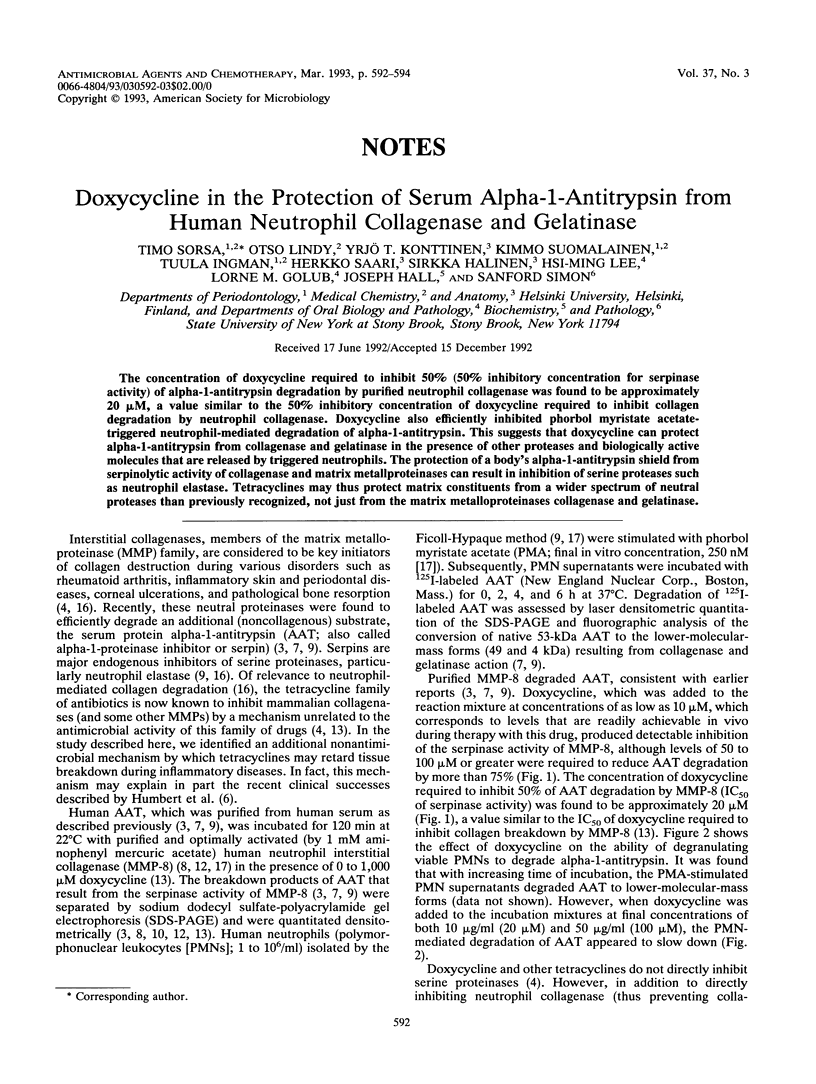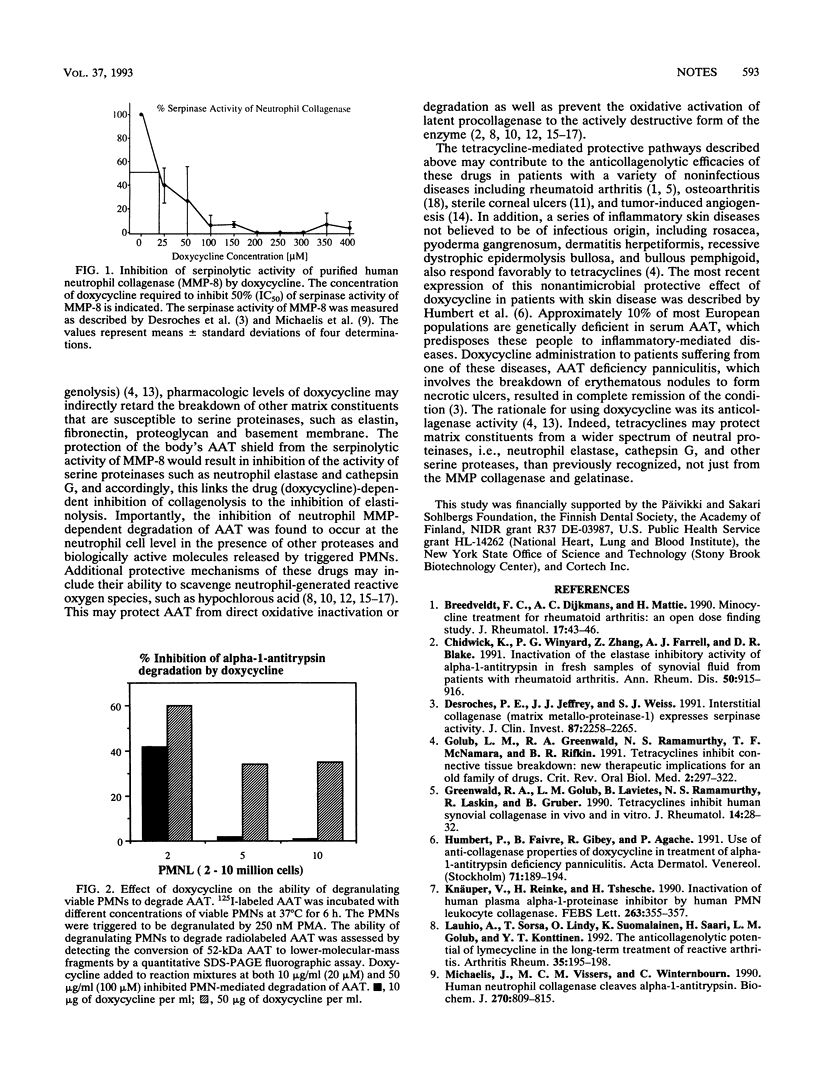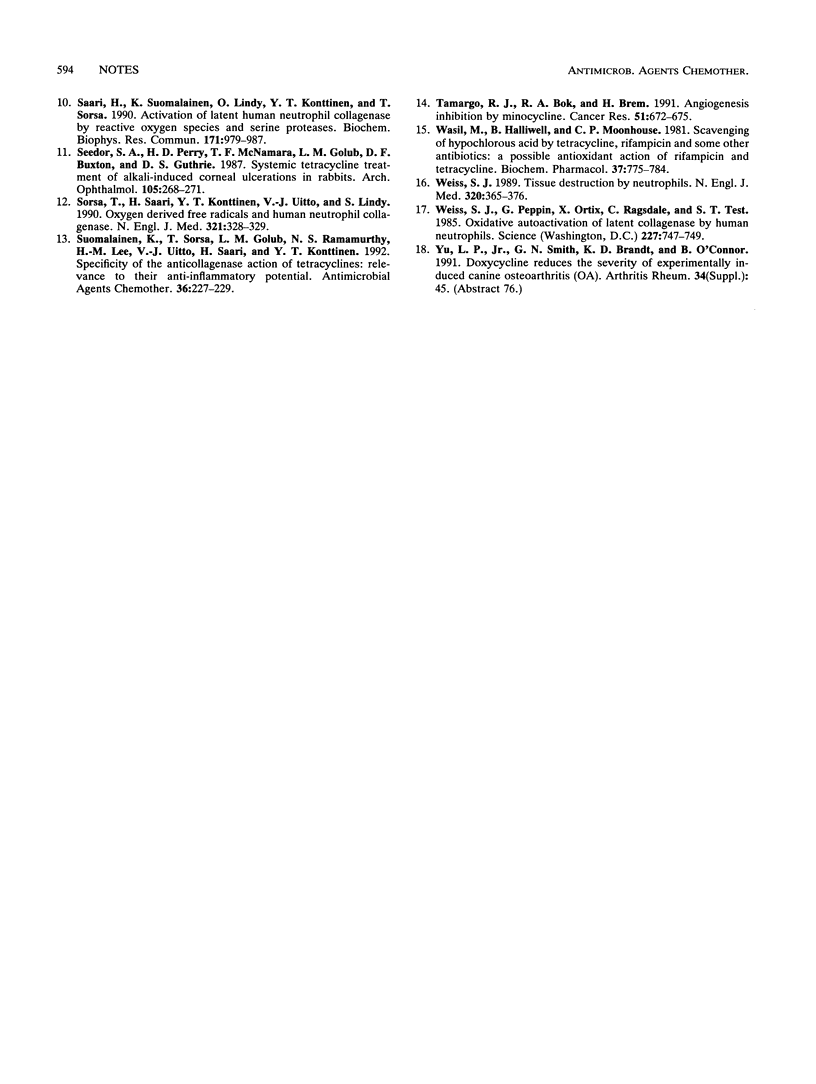Abstract
The concentration of doxycycline required to inhibit 50% (50% inhibitory concentration for serpinase activity) of alpha-1-antitrypsin degradation by purified neutrophil collagenase was found to be approximately 20 microM, a value similar to the 50% inhibitory concentration of doxycycline required to inhibit collagen degradation by neutrophil collagenase. Doxycycline also efficiently inhibited phorbol myristate acetate-triggered neutrophil-mediated degradation of alpha-1-antitrypsin. This suggests that doxycycline can protect alpha-1-antitrypsin from collagenase and gelatinase in the presence of other proteases and biologically active molecules that are released by triggered neutrophils. The protection of a body's alpha-1-antitrypsin shield from serpinolytic activity of collagenase and matrix metallproteinases can result in inhibition of serine proteases such as neutrophil elastase. Tetracyclines may thus protect matrix constituents from a wider spectrum of neutral proteases than previously recognized, not just from the matrix metalloproteinases collagenase and gelatinase.
Full text
PDF


Selected References
These references are in PubMed. This may not be the complete list of references from this article.
- Breedveld F. C., Dijkmans B. A., Mattie H. Minocycline treatment for rheumatoid arthritis: an open dose finding study. J Rheumatol. 1990 Jan;17(1):43–46. [PubMed] [Google Scholar]
- Chidwick K., Winyard P. G., Zhang Z., Farrell A. J., Blake D. R. Inactivation of the elastase inhibitory activity of alpha 1 antitrypsin in fresh samples of synovial fluid from patients with rheumatoid arthritis. Ann Rheum Dis. 1991 Dec;50(12):915–916. doi: 10.1136/ard.50.12.915. [DOI] [PMC free article] [PubMed] [Google Scholar]
- Desrochers P. E., Jeffrey J. J., Weiss S. J. Interstitial collagenase (matrix metalloproteinase-1) expresses serpinase activity. J Clin Invest. 1991 Jun;87(6):2258–2265. doi: 10.1172/JCI115262. [DOI] [PMC free article] [PubMed] [Google Scholar]
- Golub L. M., Ramamurthy N. S., McNamara T. F., Greenwald R. A., Rifkin B. R. Tetracyclines inhibit connective tissue breakdown: new therapeutic implications for an old family of drugs. Crit Rev Oral Biol Med. 1991;2(3):297–321. doi: 10.1177/10454411910020030201. [DOI] [PubMed] [Google Scholar]
- Greenwald R. A., Golub L. M., Lavietes B., Ramamurthy N. S., Gruber B., Laskin R. S., McNamara T. F. Tetracyclines inhibit human synovial collagenase in vivo and in vitro. J Rheumatol. 1987 Feb;14(1):28–32. [PubMed] [Google Scholar]
- Humbert P., Faivre B., Gibey R., Agache P. Use of anti-collagenase properties of doxycycline in treatment of alpha 1-antitrypsin deficiency panniculitis. Acta Derm Venereol. 1991;71(3):189–194. [PubMed] [Google Scholar]
- Knäuper V., Reinke H., Tschesche H. Inactivation of human plasma alpha 1-proteinase inhibitor by human PMN leucocyte collagenase. FEBS Lett. 1990 Apr 24;263(2):355–357. doi: 10.1016/0014-5793(90)81412-h. [DOI] [PubMed] [Google Scholar]
- Lauhio A., Sorsa T., Lindy O., Suomalainen K., Saari H., Golub L. M., Konttinen Y. T. The anticollagenolytic potential of lymecycline in the long-term treatment of reactive arthritis. Arthritis Rheum. 1992 Feb;35(2):195–198. doi: 10.1002/art.1780350211. [DOI] [PubMed] [Google Scholar]
- Michaelis J., Vissers M. C., Winterbourn C. C. Human neutrophil collagenase cleaves alpha 1-antitrypsin. Biochem J. 1990 Sep 15;270(3):809–814. doi: 10.1042/bj2700809. [DOI] [PMC free article] [PubMed] [Google Scholar]
- Saari H., Suomalainen K., Lindy O., Konttinen Y. T., Sorsa T. Activation of latent human neutrophil collagenase by reactive oxygen species and serine proteases. Biochem Biophys Res Commun. 1990 Sep 28;171(3):979–987. doi: 10.1016/0006-291x(90)90780-q. [DOI] [PubMed] [Google Scholar]
- Seedor J. A., Perry H. D., McNamara T. F., Golub L. M., Buxton D. F., Guthrie D. S. Systemic tetracycline treatment of alkali-induced corneal ulceration in rabbits. Arch Ophthalmol. 1987 Feb;105(2):268–271. doi: 10.1001/archopht.1987.01060020122043. [DOI] [PubMed] [Google Scholar]
- Suomalainen K., Sorsa T., Golub L. M., Ramamurthy N., Lee H. M., Uitto V. J., Saari H., Konttinen Y. T. Specificity of the anticollagenase action of tetracyclines: relevance to their anti-inflammatory potential. Antimicrob Agents Chemother. 1992 Jan;36(1):227–229. doi: 10.1128/aac.36.1.227. [DOI] [PMC free article] [PubMed] [Google Scholar]
- Tamargo R. J., Bok R. A., Brem H. Angiogenesis inhibition by minocycline. Cancer Res. 1991 Jan 15;51(2):672–675. [PubMed] [Google Scholar]
- Wasil M., Halliwell B., Moorhouse C. P. Scavenging of hypochlorous acid by tetracycline, rifampicin and some other antibiotics: a possible antioxidant action of rifampicin and tetracycline? Biochem Pharmacol. 1988 Feb 15;37(4):775–778. doi: 10.1016/0006-2952(88)90159-1. [DOI] [PubMed] [Google Scholar]
- Weiss S. J., Peppin G., Ortiz X., Ragsdale C., Test S. T. Oxidative autoactivation of latent collagenase by human neutrophils. Science. 1985 Feb 15;227(4688):747–749. doi: 10.1126/science.2982211. [DOI] [PubMed] [Google Scholar]
- Weiss S. J. Tissue destruction by neutrophils. N Engl J Med. 1989 Feb 9;320(6):365–376. doi: 10.1056/NEJM198902093200606. [DOI] [PubMed] [Google Scholar]


